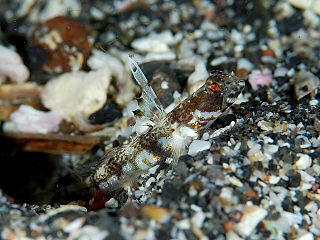
Amblyeleotris steinitzi, Steinitz' prawn goby or simply Steinitz' goby, is a species of small fish in the family Gobiidae. It lives in association with an alpheid shrimp and is found from the Red Sea through the Indian Ocean to the western Pacific Ocean.

The doublesash butterflyfish,, also known as the fourbanded butterflyfish or Marley’s butterflyfish, is a species of marine ray-finned fish, a butterflyfish belonging to the family Chaetodontidae. It is found in the southwestern Indian Ocean and the extreme southwestern Atlantic Ocean off southern Africa.

Periophthalmus is a genus of fish in the family Oxudercidae, native to coastal mangrove wood and shrubland in the Indo-Pacific region, except for P. barbarus from the Atlantic coast of Africa. It is one of the genera commonly known as mudskippers. All Periophthalmus species are aggressive and territorial.

The banded angelfish, also known as the bandit angelfish and three spine angelfish, is a distinctive species ray-finned fish belonging to the family Pomacanthidae. It is endemic to deeper reefs in Hawaii and the Johnston Atoll.

Centropyge tibicen, the keyhole angelfish, black angelfish, whitespot angelfish or puller angelfish, is a species of marine ray-finned fish, a marine angelfish belonging to the family Pomacanthidae. It is found in the Indo-Pacific region.

Assessor macneilli, the blue devilfish or blue scissortail, is a fish from the southwest Pacific Ocean. It occasionally makes its way into the aquarium trade. It grows to 6 centimetres (2.4 in) in length. It is purple-blue with long fins.

Centropyge multispinis, known by the common names bluefin dwarf, brown pygmy angelfish, dusky angelfish, dusky cherub, many-spined angelfish, and multispined angelfish, is a species of marine ray finned fish, a marine angelfish belonging to the family Pomacanthidae. It is found in tropical waters of the Indo-Pacific area.

The Atlantic mudskipper is a species of mudskipper native to fresh, marine and brackish waters of the tropical Atlantic coasts of Africa, including most offshore islands, through the Indian Ocean and into the western Pacific Ocean to Guam. The Greek scientific name Periophthalmus barbarus is named after the eyes that provide the Atlantic mudskipper with a wide field of vision. The Atlantic mudskipper is a member of the genus Periophthalmus, which includes oxudercine gobies that have one row of canine-like teeth.

The Barred Mudskipper or Silverlined Mudskipper is a species of Mudskippers native to marine, fresh and brackish waters from the African coast of the Indian Ocean to the Marianas and Samoa in the western Pacific Ocean and from the Ryukyus south to Australia. This species occurs in Mangrove Forests and Nipa Palm stands and can cross surfaces of mud while out of the water. This species can reach a length of 19 centimetres (7.5 in) TL. It can also be found in the aquarium trade.
Parasites of the Barred Mudskipper include Acanthocephalan larvae and the small Opecoelid Digenean parasite in the intestine and described from fish collected in New Caledonia.

Chaetodon hoefleri, the four-banded butterflyfish, is a species of marine ray-finned fish, a butterflyfish from the family Chaetodontidae. It is native to the tropical eastern Atlantic and has been recorded in the Mediterranean.
Elacatinus chancei, the shortstripe goby, is a species of ray-finned fish in the family Gobiidae. It lives inside or on the surface of a sponge and occurs in tropical waters in the west central Atlantic Ocean, the Bahamas, the Antilles, and Venezuela.

The arrow goby is a species of goby native to marine and brackish waters of the Pacific coast of North America from British Columbia to Baja California. This species grows to a length of 6.4 centimetres (2.5 in) SL, though most do not exceed 4.2 centimetres (1.7 in) TL. This fish can also be found displayed in public aquaria. This species is the only known member of its genus.

Chaetodontoplus melanosoma, the black-velvet angelfish, brown angelfish, or phantom angelfish, is a species of marine ray-finned fish, a marine angelfish belonging to the family Pomacanthidae. It is found in the western Pacific Ocean.

Chaetodontoplus mesoleucus, the vermiculated angelfish, is a species of marine ray-finned fish, a marine angelfish belonging to the family Pomacanthidae. It is found in the Indo-West Pacific region.

Selene setapinnis, the Atlantic moonfish, is a West Atlantic fish belonging to the family Carangidae.

Genicanthus melanospilos, the spotbreast angelfish, blackspot angelfish or swallowtail angelfish, the family Pomacanthidae. It occurs in the Indo-West Pacific region.

Selar boops, the oxeye scad, is a species of ray-finned fish in the family Carangidae, the scads, jacks and trevallies. It is found in the Indo-Pacific. It is an important species for fisheries in some parts of its range.

Periophthalmodon septemradiatus is a species of mudskipper found along tropical shorelines of the eastern Indian Ocean where it occurs in marine, brackish and fresh waters from India to Indonesia. It is found along in estuaries as well as in the rivers.

Tomiyamichthys alleni, Allen's shrimpgoby, is a species of ray-finned fish from the family Gobiidae. It occurs in the western Pacific Ocean where its is commensal with an aplheid shrimp.
Chelmon muelleri, the blackfin coralfish or Muller's coralfish, is a species of marine ray-finned fish, a butterflyfish in the family Chaetodontidae. It is a reef fish which is endemic to Australia.

















